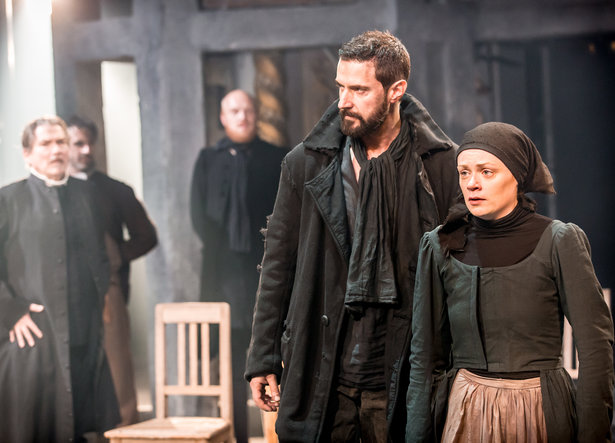The posters all over the Underground scream Richard Armitage. As far as they are concerned The Crucible is the finest one-man-show since Clarence Darrow. But what we get in performance is something much more thrilling (if less pin-uppable): a ferocious ensemble piece, fresh and urgent, that turns the moral and emotional screw over three and half exhilarating – yes really – hours.
If ever there was a play worth gutting the Old Vic to turn it into a theatre-in-the-round then it’s Arthur Miller’s The Crucible – a work which invites us all to judge and be judged, to gaze suspiciously at our neighbours and shrink from theirs in our turn.
Armitage makes a fine job of John Proctor, but it’s Madeley who moves
Confined in these close quarters, this Crucible becomes more the chamber drama it really is than the crowd piece it can so easily become – a story that plays out not in the courtroom itself but the anteroom, in a cell, a bedroom, a stable. These are private, domestic dramas suddenly elevated to public spaces in which they do not belong, and intruding on their grubby intimacy we feel that same discomfort, that same distaste, for a regime the peers in at windows and into hearts to assess and condemn.
 Director Yaël Farber plays things straight. Some may balk at the long running time, but there’s little clutter or bagginess of thought in a visually traditional production that allows Miller’s allusive parable to work its premise through to its devastating conclusion. If pushed, I could do without the silent framing dramas that begin Acts I and II, rich in gothic ritual and domestic details, respectively, but the stillness of these opening moments does effectively anchor the force and physicality of what’s to come.
Director Yaël Farber plays things straight. Some may balk at the long running time, but there’s little clutter or bagginess of thought in a visually traditional production that allows Miller’s allusive parable to work its premise through to its devastating conclusion. If pushed, I could do without the silent framing dramas that begin Acts I and II, rich in gothic ritual and domestic details, respectively, but the stillness of these opening moments does effectively anchor the force and physicality of what’s to come.
In such a long piece pacing is all, and Farber’s arcs are carefully managed. Directing in one long dramatic legato, she finds the inner emotional rhythms of Miller’s long scenes, setting the staccato encounters of Deputy Governor Danforth (Jack Ellis) against the sustained unspokens of John and Elizabeth Proctor (Richard Armitage, pictured above with Natalie Gavin as Mary Warren, and Anna Madeley).
 The charge between this husband and wife is live indeed. Proctor’s encounter with Abigail (a fierce, sullen Samantha Colley) is long since past here, transformed into violence – a chemistry quietly but surely displaced by Madeley’s soft dignity and fragile determination. Armitage makes a fine job of John Proctor – a roaring, contrarian beast of a man who shouts because he cannot be heard, but it’s Madeley (pictured left with Armitage) who moves.
The charge between this husband and wife is live indeed. Proctor’s encounter with Abigail (a fierce, sullen Samantha Colley) is long since past here, transformed into violence – a chemistry quietly but surely displaced by Madeley’s soft dignity and fragile determination. Armitage makes a fine job of John Proctor – a roaring, contrarian beast of a man who shouts because he cannot be heard, but it’s Madeley (pictured left with Armitage) who moves.
The surrounding cameos glow with human detail in Soutra Gilmour’s shadowy sets: Ann Firbank’s forthright martyr Rebecca Nurse; Harry Atwell’s Thomas Puttnam, crawling and convulsing with anger and jealousy; the misplaced learning and logic of Jack Ellis’s Danforth. And then there are the girls. Moving as one, staring and silently accusing, their courtroom hysteria is horrible and very, very believable.
Every generation adds their own ingredient to Miller’s Crucible. Mixed in with the perennial instincts of revenge, jealousy, hysteria and self-preservation are more topical thoughts and reactions. It’s hard to watch the women here obsessively adjusting their all-covering headscarves, to hear Danforth’s horror that the girls were “dancing”, to witness the mindless solution of violence offered in the name of faith, and not think of the recent developments in Iraq and Syria. It’s an important time to be reminded that Christianity has its own dark history of fundamentalism and oppression in the name of religion, that these are conflicts we have lived before.
As we face one another across Farber’s circular space, reflected back on ourselves hundredfold, we bear witness not only to an alien tragedy but to our own history, just as Miller intended.
- The Crucible is at the Old Vic until 13 September















Add comment